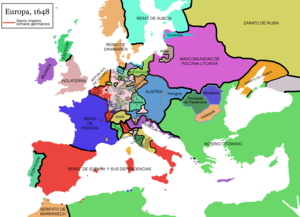Equestrian Statue Of Constantine
At The Scala Regia Of The Vatican (Bernini)

The vision of Constantine
is a sculpture made by the artist Gian Lorenzo Bernini, located on the wall opposite the main doors at the extreme right on the atrium in the Scala Regia of St.Peter’s Basilica, in
the Vatican City, Italy. It's a portico with a marble relief. Possibly commissioned bh Pope
Innocent X. It was made between 1662 and 1668. Here Bernini show the instant of the conversion to christianism of Constantine The Great. He use the Baroque idea of a chargued space and capturing a exact moment. The horse and his rider are looking of the cross above their, responding to the image that they see. In the sculpture there are a lot of movement, like the horseman's cloths and the drapery behind him. The horse is supported by his hind legs, and he have his hair of his tail and his mane exaggerated. This concept of theatricality is only of the Baroque Era. The sculpture is so big, so people say that one door of the Bernini's studio had to tear down because if not the statue couldn't pass.
In 1654,
the original plan was to place the sculpture within St. Peter’s basilica. One year later, Alexander VII assumed the
papal throne and the project was reinvigorated, securing the arrival of a big
block of marble which Bernini could use, but for unclear reasons, the project
was delayed and Bernini didn’t start working in the sculpture until 1662. He finished
at the end 1668, but it didn’t arrive to the Scala Regia until the 12th of January of
1669. As an Christian ruler, the figure of Constantine was particulary
appealing to later popes, in the 17th century.
As you
can see, its an equestrian sculpture, in which appears Constantine on a horse
and he’s pointing straight. This have a lot of story:
Benini’s captured one particular moment of Constantine’s life. He was the first christian emperor. Before a battle with the Pagan Roman Emperor,
he was praying with his army. After a period of time a cross appeared
in the sky shinning with the incription “Hoc Signo Vinces” which means “by this sign, you will
conquer”. This gave the troops sufficient belief to overwhelm
Maxentius at the Battle of Milvian Bridge, after which Constantine made a triumphal
entry to Rome, with which he granted the Religious toleration. After ten years of this miracle, this emperor start with the work of San Pedro.
The Triumph Of Bacchus
(Velázquez)
The Triumph of Bacchus, also called The Drinkers, was painted by Diego Rodríguez Velázquez. He finished it between 1628 and 1629. Its dimensions are 165x225cm. Velázquez use the Oil on canvas technique. It was included in the Spanish Royal Collection.
Bacchus is an ancient Roman God. In the painting, he’s on the left and he’s very luminous, his dominant but relaxed pose somewhat reminiscent of that of Christ in many Last Judgements. Bacchus and the person behind him are represented in the traditional clothes used for depictions of classical Myth. The god’s faceis highlightened by the clear light which illuminated him in a more classicist style.
On the right side, are present some drunkards, that invite us to join their party, with a very Spanish atmosphere. In contrast with this God, Bacchus, the other people are poor people, wearing hides like clothes, but they're happy, like in a party. Also we can see the contrast between the three figures of the left side(Bacchus, the satiro and the ducking man) and on the right side(the citizens), because the figures on the left side are more divines, with perfect bodies and young faces, and on the right side there are real mens, with problems but now they forget because they're like in a party with wine. The figure kneeling in front of the God is younger and better dressed than others. The figures are shown with chiaroscuro and have much darker skin.
In this work, Velázquez adopted a realist treatment of a mythological subject, a tendency he would pursue further during the following years.There are various elements of naturalism in this work, such as the battle and pitcher.It received a number of a rather grand and elaborate idealized treatments in Renaissance Art. But it have also Baroque aspects, like that all people occupied the foreground of the picture and filling a large section of the painting. Also there are a lot of movement, and the picture is very close.
Veláquez's portrait.
-http://en.wikipedia.org/wiki/The_Triumph_of_Bacchus
Work made by Débora Torres. I hope that you like it.






